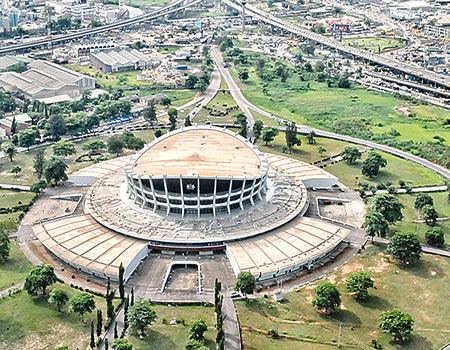The National Arts Theatre, Iganmu, located on a strategic strategic expansive parcel of land, in Lagos, is the intended primary centre for the performing arts in Nigeria. The monument was constructed and completed in 1976, in preparation for the Festival of Arts and Culture (FESTAC) in 1977. The construction was started by the military regime of General Yakubu Gowon and completed during the regime of General Olusegun Obasanjo. Its exterior is shaped like a military hat and houses a 5,000-seater main hall with collapsible stage, two capacity cinema halls, VIP lounges and other smaller meeting areas. The National Arts Theatre was designed and constructed by Bulgarian construction companies and resembles the Palace of Culture and Sports in Varna, Bulgaria (completed in 1968), the National Arts Theatre Lagos being the bigger of the two.
However, while its original in Bulgaria still remains a fully functional sporting arena with a 6000 capacity main sporting hall, Nigeria’s replica, after its original intended use for FESTAC ’77, has battled abandonment, neglect and rot till present day. A visit to the complex was quite revealing; still imposing, the National Arts Theatre is a sleeping giant.
Forty two years on, neglect and poor management by successive governments has turned the eye-popping elegant edifice into a symbol of ruin and decadence. Deserted, many lawns bushy, visible areas of rot and disrepair, a failed air conditioning system, dark halls and walkways due to epileptic power supply are some of the present state of the once exalted National Arts Theatre.
Despite few interventions, the huge main bowl of the theatre is not what it was envisaged to be. Still ranked the largest in Africa, bigger than that of Durban and Cape Town in South Africa, the theatre has not been fully utilised since 1977. The current administration, through Lai Mohammed, Minister of Information and Culture, gave some of the facilities a facelift, including the VIP lounges and meeting rooms, but the main hall remains locked and unused.
The first attempt to rewrite the story of the theatre was in 2001. Then, President Obasanjo had announced plans to privatise it which sparked off controversy in the arts community. Notable voices, including Nobel Laureate Professor Wole Soyinka were against the move. Actors and actresses staged a series of protests against the sell-off plans. There were arguments that buyers of the theatre would use it to enrich themselves and not promote arts and culture.
The plan was dumped. Again, when Edem Duke became the Minister of Culture in 2011 and toured its facilities, he was told by the theatre’s General Manager and CEO then , Kabir Yusuf, that they needed about N500 million to acquire a chiller for the humid main bowl, which was last used in 1994 for the screening of the late Hubert Ogunde’s famous film, Ayanmo.
Perhaps sure that the Federal Government would not put such money into the edifice, the minster proposed that corporate Nigeria should step in to assist in restoring the glory of the theatre. Again, it was trailed by controversy, fuelled by claims that the edifice was planned for a five-star hotel.
Yusuf, in defence, had said the Federal Government had no plan to turn the nation’s former number one event centre into a five-star hotel. He said, instead, government was implementing the business segment of the master-plan of the then 37-year-old edifice.
He said the National Arts Theatre would not be touched and would still remain and function as the nation’s foremost cultural and event venue.
He said, “There is no issue of touching the National Theatre. What government is doing is to lease the landed properties surrounding the edifice to investors to develop. This is a way to save the theatre instead of outright sale. The facilities earmarked for the business phase of the complex, which is in tandem with the master-plan of the theatre include a five-star hotel, shopping mall, multi-level car park, land and water restaurants as well as offices.
“Serious businessmen are showing strong interest in the land and we can’t leave it to miscreants.
The current facilities on ground around the theatre cannot support the growth of the theatre. And we are sitting on gold.”
This, he said, necessitated a memo to the Presidency of Goodluck Jonathan for approval, which was granted.
“He added, “All the preliminary works would be wrapped up in three months.” However, the plans, eventually, weren’t realised.
In April 2013, controversy around the use of the theatre site again arose, and quickly became emblematic of the fraught relationship between culture and development in Lagos.
Rumours surfaced that the National Theatre would be sold by the federal government and replaced by a five-star hotel. Following the outrage that greeted the response, the federal government eventually made it clear that they were proposing the development of land surrounding the theatre, where the Lagos Rail Mass Transit Project is already under construction, into a hotel, restaurants, offices, shopping malls. The same year, stakeholders in the sector held a peaceful demonstration to call on the then Jonathan-led administration to jettison the plan to turn the place into a cash cow.
Recent calls for the proposed sale/privatisation of one of the country’s crown jewels to pull the economy out of recession, has met stiff opposition from well-meaning Nigerians, arts connoisseurs and economic experts who described it as a dangerous move by the President Muhammadu Buhari administration, should rumours turn out to be true.
However, pending the government’s decision, stakeholders opine that the National Arts Theatre, if given deserved recognition in present day, could out-bid the best event centres in Lagos.
Akin Orogun, a filmmaker, during a chat with the Nigerian Tribune, stressed that the biggest and the most celebrated event centres in Lagos had nothing on the National Arts Theatre. He said, “Look around you. See the quality of this edifice. See how the sound engineering and acoustics were carefully done because the building was originally intended for the celebration of arts. This venue should naturally be the number one choice for the biggest musical concerts, symposiums, festivals etc. It is way better than any of the celebrated events places in Lagos and in Nigeria. In fact, national events should be held here. Look at the abandoned facilities; see the expansive car park, the serenity of the grounds, and the rich cultural history within. Abandoning this massive masterpiece is one of the biggest mistakes of government because it is a gold mine waiting to be tapped. Entertainment is a multi-billion naira industry in Nigeria now and places like this should be a beehive of various activities”.
Another respondent, Tonia Okplala, said that the complex should be privatised, so that it could be efficiently managed.
“Why is the Federal Government holding onto it if they have no plans for it. Nigerians have lost faith in the government agencies effectively handling monuments of this magnitude and we see how private establishments flourish because businessmen would not takes losses as an alternative. The government can lease the building and insist on what it should be used for and I am optimistic that the National Arts Theatre would become an immediate tourist’s destination and events place. See for yourself, save for the bars on the grounds which attract people especially in the evenings, what else is constant here? Some churches and corporate bodies rent some of the small available functioning spaces but that is about it. Nothing much happens here sadly,” she said.
Also, within the National Arts Theatre is the National Gallery of Modern Art. It is largely non-functional. Here, works of many renowned Nigerian artists are covered in dust. Busts of kings (Ooni of Ife, Oba of Benin) and queens (Queen Amina, Queen Idia) share the gallery space with paintings of Nigeria’s historical personalities (Uthman dan Fodio, Ajayi Crowder, Herbert Macaulay), cultural superstars (Wole Soyinka, Chinua Achebe) and former heads of states and presidents (Murtala Mohammed, Yakubu Gowon, Shehu Shagari). The works of various artists exploring various aspects of Nigeria’s traditional life, deities and icons, markets etc sit therein unappreciated. Almost every aspect that represents Nigeria as an entity is highlighted in the gallery now appear uninspiring, no thanks to the improper environment they have been kept in these many years.
Like the National Arts Theatre, the gallery should have been a monument or site of national pride and should be top on the itinerary of school excursions; a visit here by pupils will help to ground the kids in their heritage, like the National Museum in Onikan is already doing. Though funded by government, the decree establishing the Gallery (in 1993) provides that it could generate additional revenues from the sale of art works, books and publications. That is also, obviously not happening.
While the challenges posed to the state and future of the National Arts theatre remain gloom, its potentials, if fully functional, could be of immense financial gain to the government. Why stakeholders and potential investors wait with bated breath to see whether the government gives assent to the re-glorification of one of its national treasures, the monument that is the National Arts Theatre remains only but another sleeping giant or misplaced priority.







